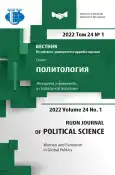«Хрупкое представительство», или Женщины в большой политике: случай административной элиты
- Авторы: Колесник Н.В.1
-
Учреждения:
- Социологический институт РАН - филиал ФНИСЦ РАН
- Выпуск: Том 24, № 1 (2022): Женщины и феминизм в глобальной политике
- Страницы: 107-119
- Раздел: РЕГИОНАЛЬНОЕ СОТРУДНИЧЕСТВО И ИНТЕГРАЦИЯ
- URL: https://journal-vniispk.ru/2313-1438/article/view/322593
- DOI: https://doi.org/10.22363/2313-1438-2022-24-1-107-119
- ID: 322593
Цитировать
Полный текст
Аннотация
В работе представлены результаты эмпирического исследования административной элиты десяти российских регионов (г. Москва, г. Санкт-Петербург, Ленинградская, Ростовская, Калининградская, Костромская и Новосибирская области, Хабаровский и Ставропольский край, Республика Дагестан). Анализ социально-демографических характеристик административной элиты показал, что существенных различий по возрасту, месту рождения, типу и месту полученного первого высшего образования (и последующего) между мужчинами и женщинами практически не наблюдается. Исследование карьерных траекторий женщин в министерской элите показало, что чаще всего они занимают элитные позиции, как и мужчины, в среднем возрасте, реже приходят из экономических и силовых структур, горизонтальные и вертикальные перемещения в большинстве случаев осуществляют в рамках одной профессиональной институции - органов исполнительной власти. В работе были выделены региональные правительства со схожими гендерными характеристиками (относительного гендерного паритета и относительного гендерного дисбаланса). В ходе исследования выявлено, что в приграничных и экономически успешных регионах формируются более феминизированные правительства, а режим гендерного дисбаланса в правительстве чаще всего характерен для экономически зависимых регионов и тех, что расположены на юге РФ (за некоторым исключением).
Ключевые слова
Об авторах
Наталья Владимировна Колесник
Социологический институт РАН - филиал ФНИСЦ РАН
Автор, ответственный за переписку.
Email: n.kolesnik@socinst.ru
ORCID iD: 0000-0003-2323-6799
кандидат социологических наук, старший научный сотрудник
Санкт-Петербург, Российская ФедерацияСписок литературы
- Aivazova, S.G. (2012). Gender characteristics of the political behavior of russians in the context of the electoral cycle of the parliamentary and presidential elections of 2011–2012. Woman in Russian society, 3, 3–11. (In Russian).
- Albanesi, C., Zani, B., & Cicognani, E. (2012). Youth civic and political participation through the lens of gender: The Italian case. Human Affairs, 22(3), 360–374.
- Angapova, O.B. (2014). Classification of border regions of the Russian Federation. Bulletin of Buryat State University, 2, 76–80. (In Russian).
- Annesley, C., & Franceschet, S. (2015). Gender and the executive branch. Politics & Gender, 11, 613–617.
- Belyaeva, G.F. (2008). Political activity of women. Issues of state and municipal administration, 1, 143–164. (In Russian).
- Bernard, R., Davis, S.S., & Teele, D.L. (2021). To Emerge? Breadwinning, motherhood and women’s decisions to run for office. American Political Science Review, 115(2), 379–394.
- Bright, J., Doering, H., & Little, C. (2015). Ministerial importance and survival in government. Tough at the top? West European Politics, 38(3), 441–464.
- Chirikova, A.E., & Lapina, N.Yu. (2009). Woman on the highest floors of government. Russian practices and French experience. INAB, 3. M. Institute of Sociology, RAS. (In Russian).
- Costa Pinto, A., Cotta, M., & Tavares de Almeida, P. (Eds.). (2017). Technocratic ministers and political leadership in European democracies. London: Palgrave.
- Druckmann, J.N., & Warwick, P.V. (2005). The missing piece: measuring portfolio salience in western European democracies. European Journal of Political Research, 44(1), 7–42.
- Escobar-Lemmon, M., & Taylor-Robinson, M. (2005). Women ministers in Latin American government: when, where, and why? American Journal of Political Science, 49(4), 829–844.
- Khasbulatova, O.A. (2014). Gender approach as a technology to improve the effectiveness of personnel policy. Woman in Russian society, 4, 3–10. (In Russian).
- Kolesnik, N.V. (2021). Gender (not) equality in the political power of the Russian regions. Monitoring of public opinion: economic and social changes, 4, 468–491. (In Russian).
- Krook, M.L., & Mackay, F. (Eds.). (2011). Gender, politics and institutions: toward a feminist institutionalism Basingstoke: Palgrave.
- Krook, M.L., & O’Brien, D.Z. (2012). All the president’s men? The appointment of female cabinet ministers worldwide. Journal of Politics, 74(3), 840–855.
- Nikolaev, A.N. (1995). The formation of the technocratic elite in Russia: historical and sociological aspects. Saratov: Ed. center of the Saratov State Academy of Economics, 166 p. (In Russian).
- Ovcharova, O.G. (2007). Gender asymmetry in politics: the search for an institutional solution to the problem. Bulletin of the Saratov State Academy of Law, 5(57), 214–219. (In Russian).
- Popova, О.V. (2013). Gender aspects of the political career of the Russian subfederal elite: opinions of experts. Woman in Russian society, 3, 21–30. (In Russian).
- Tartakovskaya, I.N. (2015). Reproduction of gender order through career strategies: an attempt at intersectional analysis. Sociological research, 5, 84–93. (In Russian).
- Tartakovskaya, I.N. (2017). Femininity of precarity. Interaction. Interview. Interpretation, 14, 45–53. (In Russian).
- Verzichelli, L. (2018). Executive Elites. In H. Best & J. Higley (Eds.), The Palgrave Handbook of Political Elites (pp. 363–380). London: Palgrave Macmillan.
- Whitford, A., Wilkins V., & Ball, M.G. (2007). Descriptive representation and policymaking authority: evidence from women in cabinets and bureaucracies. Governance, 20(4), 559–580.
- Zadorin, I.V. (2018). Regions of the frontier: territorial identity and perception of “special”. Politics, 2(89), 102–136. (In Russian).
Дополнительные файлы









